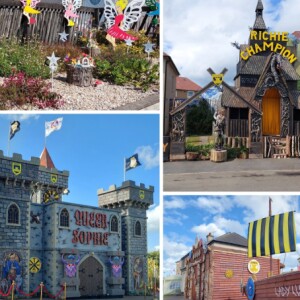Today S’s cousin and her husband took us to see some of the “arches” in Boness before tomorrow’s annual Fair and parade. Boness Fair is reputed to be the largest children’s fair in Britain and is a great community event with hundreds of primary school children taking part. Flags flutter in gardens and decorated arches stand outside the homes of the main characters taking part. It’s a time of great pageantry with the crowning of the Queen who is attended by various members of court including Lords and Ladies in Waiting, Heralds, a Crown Bearer, Guards, various other courtiers, Flower Girls and Fairies. The costumes are very elaborate and some of the arches are works of art showing great ingenuity and inventiveness. Queen Sophie’s castle must have extended her actual house considerably and the Champion’s house resembles a Norse church and many arches relate to stories or themes chosen by each school. This year the courtiers are from Kinneil School and the theme chosen is the “Age of the Vikings” with symbols, runes, mythological creatures, Vikings and several ships on display including this one of the two goats that pull Thor’s chariot with the sound of thunder and sparks of lightning erupting from the chariot wheels as they cross the sky
The fair originated as a day to celebrate when the miners were released from servitude, and at the end of the 19th century it became a day of pageantry with children being the focus. Acts of 1606 and 1641 had effectively enslaved the miners and were not repealed until 1799.To celebrate their emancipation the miners of Boness and their families held an annual festival which was later transformed into the Boness Children’s Fair Festival, now called the Boness Fair Day.
Bo’ness Fair Day is now the largest and most spectacular of its kind in the country. Interestingly it began in the early 1780s as a celebration for miners no longer being tied to the mines from the day they are born thanks to a law that was passed forbidding the thirling of miners and their families to the coal pits. Freedom was granted to all in 1779 with an Act declaring that, “all the colliers in that part of Great Britain called Scotland, are hereby declared to be free from their servitude.”
Until the latter part of the 18th century, it was customary for all Scottish miners to be thirled, that is, bound to the pits, as were any children who were born to them while they worked in them. Thus the bondage was continued from generation to generation and if any of the miners tried to escape from virtual slavery the colliery masters had the power to send their overseers to drag them back and to punish them severely. Even when a colliery owner sold his pit, the miners were included as part of the transaction. At last, 1774, a law was passed forbidding the thirling of miners and their families to the coal pits, but those already tied to the mines were not granted their freedom straightaway and it was not until 1779 that an Act declared that, “all the colliers in that part of Great Britain called Scotland, are hereby declared to be free from their seritude.” It was to celebrate this new-found liberty that the miners of Bo’ness who formed a very closeknit community of their own, staged their first Fair……
Fair Day became the only holiday that they had in the year and a great contrast to people today with a guarantee of several days off during the year.

Comments
Sign in or get an account to comment.


